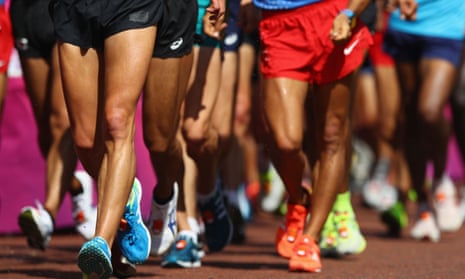A need for speed: if running is too risky, why not try race walking?

If you’re a runner prone to injury and joint problems, you may need to take up race walking. Just be prepared to look like you need the loo
Like most joggers, I’m no stranger to injury. Whether it’s a wonky knee, popped calf or tweaked hamstring, there always seems to be something wrong. But over the past few years, the number of days when I’ve been injured has slowly outnumbered the days when I could actually go for a run, and I realised I needed a different outlet for my desire to keep moving.
Then, quite literally, I stumbled across the solution – race walking. Yes, that’s right, the sport where the athletes look as if they’re bursting for the loo and are all on some mad quest to find the last unoccupied cubicle. There they go, shimmying along, buttocks clenched, drenched in sweat, snake hips swaying! Funny isn’t it, until you try it, that is …
For decades, race walking has been the laughing stock of every track and field competition from London to Lesotho. But, in terms of perseverance, grit and technical excellence, there are few events more demanding. If you don’t believe me, next time you are out for a walk (or a run) give it a try. After 10m you’ll be exhausted, yet race walkers duel it out over 20km, 35km and even 100km distances. That’s a long way to go in search of a toilet.
But the real clincher, for me and many other injury-prone joggers, is that the sport is a lot gentler on the joints than running. Because competitors have to have one foot in contact with the ground at all times, the impact on ankles, knees and hips is much reduced. And it’s this attrition that leads to so many of those frustrating wear-and-tear injuries.
READ RELATED: Singleton who tipped the scales at 22 stone reveals transformation into gym buff
It’s easy enough to get started. First, find a long line to walk along; the touchline of a football pitch is ideal. Next put one foot in front of the other, you’ll find swinging your hips helps build momentum and cadence as you master the sheer weirdness of what you are doing. Clearly, humans invented running for those occasions when we had to hunt antelopes or dash for the bus, so race walking is totally counter-intuitive. Why on earth would you put these constraints on your legs? But that is where the allure of the discipline lies.
It emerged in the 19th century out of the hugely popular British culture of pedestrianism. Massive wagers were placed on famous walkers as they undertook mind-boggling distances – 1,000-mile races were not uncommon – and the strict rules of the sport were codified to separate it from running.
It’s odd, knackering and strangely compelling. The first few times I did it I felt so silly I hid behind a hat and sunglasses. But as the weeks wore on, my awkward stumble became more of a powerful glide and I find I can sometimes “walk” past slow joggers in the park, while constantly having to monitor my technique also distracts my mind from the exhaustion of the exercise. After a few laps, I’ve had a great work-out, and best of all, I haven’t been injured in months.
Send off for a free beginner’s pack at racewalkingassociation.com
Source: Health & wellbeing | The Guardian





